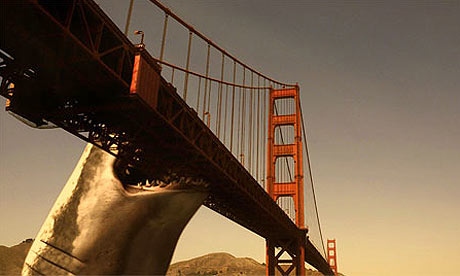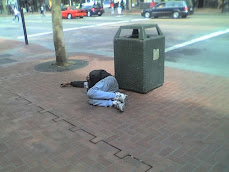I am reposting an article from Film Blog Burning bridge: why the Golden Gate is the sci-fi director's favourite target
Burning bridge: why the Golden Gate is the sci-fi director's favourite target
Melted, bitten in two, reduced to a ruin by nuclear attack – these are just some of the indignities visited on the bridge in recent movies. Is it just because New York's skyline is off limits?

Here we go again ... scene from Mega Shark Vs Giant Octopus
Nuclear terrorism is only the latest fictional indignity to hit the bridge. In the last decade directors have gone to town on the landmark. It's been variously melted (in 2003's The Core), bitten in two (in this year's Mega Shark Vs Giant Octopus) and picked up and dumped further up San Francisco Bay by a disgruntled super villain (in X-Men: The Last Stand in 2006).
In fact since 9/11 it's been rare to see any other American architectural icon so regularly and explicitly attacked on film. New York used to be an action/adventure director's playground, but for much of this decade the real-life fall of the twin towers has made it difficult to justify fictional onslaughts on the city's landmarks. The notable exception – Matt Reeves's controversial schlock-horror flick, Cloverfield, in which a giant sea monster beheads the Statue of Liberty – was damned by both right- and leftwing media for trivialising a mass trauma. Liberal news site Salon.com's Stephanie Zacharek spoke for many upset by the film when she accused Reeves of "[harnessing] the horror of 9/11 ... and [repackaging] it as an amusement-park ride".
In a genre that revels in wringing cheap thrills from expensive spectacle, that sort of criticism is hard to avoid. Still, directors have done their best to dodge controversy by detaching the fictional threat of terror from reality to a degree that they wouldn't have done 10 years ago. Danger has been neutered through amplification. Terror (often the product of otherworldly forces rather than human action) is directed at the city in general rather than a specific landmark (see 2007's I Am Legend, last year's The Happening and, especially, Sam Raimi's Spider-Man trilogy) or made so vast in scope that its effects are felt globally (2004's The Day After Tomorrow).
In comparison the Golden Gate bridge is a politically safe setting for a director's worst case scenario. It's far from New York (and close to Hollywood), instantly recognisable to an international audience and emotionally evocative to an American one. Unlike the Statue of Liberty, it's a genuine American construct, built during the Great Depression and therefore symbolic of the country's resilience – a visual metaphor for American unity, there to be smashed whenever a director needs to fast-track an audience into alienation and panic.
At the bridge's opening on 27 May 1937, its designer, Joseph Strauss, spoke of "[a bridge that] stands before you in all its majestic splendour, in complete refutation of every attack made upon it". Today that statement has been made a mockery of by the movie business but stands true in reality. It can take what Hollywood throws at it. Terminator's nuclear bomb won't tarnish it for long and, like that sturdiest of critically mauled action franchises, it'll be back.





No comments:
Post a Comment